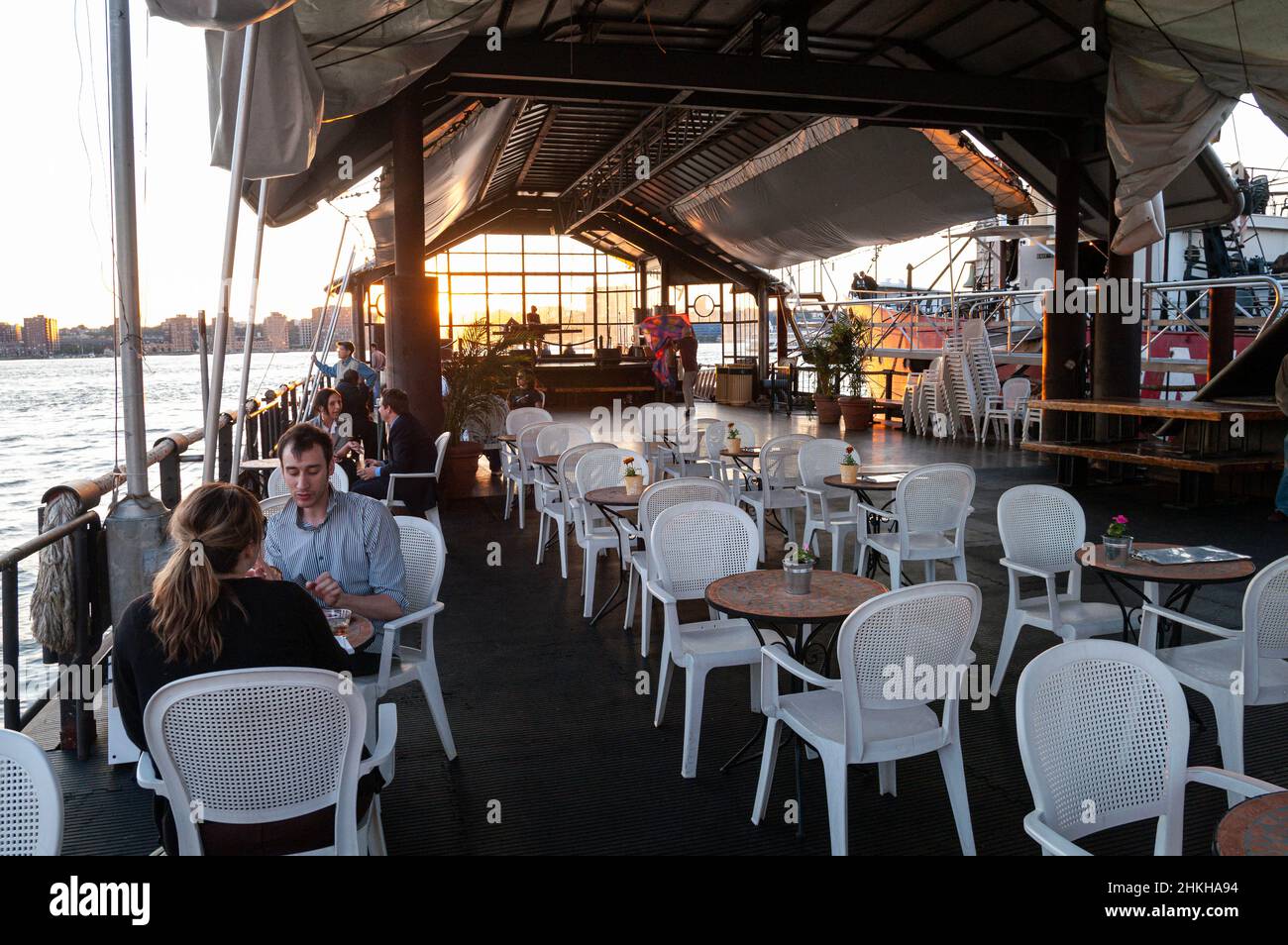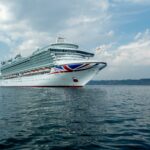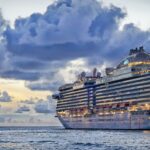Shining a Light on Seafaring History
The Lightship Frying Pan isn’t just any old ship; it’s a testament to the ingenuity of early maritime engineers and the courage of those who worked on the open ocean. This famed vessel, once a guardian angel for ships navigating the treacherous Frying Pan Shoals, has become a beloved New York City icon, symbolizing the city’s deep connection to the sea.
To understand its significance, we must journey back to the early 19th century, long before the advent of GPS. Sailors relied on maps, the stars, and their wits to navigate the vast expanse of the Atlantic. The Frying Pan Shoals, lurking ominously off the coast of Cape Fear, North Carolina, posed a constant threat. These shallow waters, often obscured from view, were notorious for snaring unsuspecting ships, earning the area the grim nickname “Graveyard of the Atlantic.”
To mitigate the danger, the first lightship took its position at the shoals in 1854, becoming the first in a lineage of floating lighthouses that would safeguard mariners for generations. These vessels, often stationed in remote and perilous locations, served as beacons of hope, warning ships of impending danger and guiding them towards safety.
Fast forward to 1929, and the Lightship Frying Pan (officially designated as LV-115) embarked on her own watch. This wasn’t your average lightship; it was the latest and greatest, outfitted with a powerful beam visible for miles and a foghorn that could rival the roar of a storm. But the Frying Pan was more than just a light and a horn; it was a lifeline, a floating communication hub connecting ships to shore, relaying vital messages and weather reports.
Then came World War II, and the Lightship Frying Pan took on a new and critical role: coastal defense. The vessel transformed into a floating checkpoint, intercepting and inspecting ships for contraband, enemy activity, and potential threats. The crew’s unwavering dedication during these uncertain times played a vital role in protecting American shores.
Following the war, the Frying Pan diligently resumed her post at the treacherous shoals. She faithfully stood watch until 1964 when technological advancements led to her decommissioning, replaced by a modern light tower. But this wasn’t the end of her story.
In 1989, a group of passionate history enthusiasts recognized the historical significance of the Frying Pan and refused to let her fade into obscurity. They rallied together, raising funds and awareness, ultimately bringing the ship to New York City, where she found a permanent home at Pier 66a.
Today, the Lightship Frying Pan is more than a relic of the past; it’s a portal to a bygone era, offering visitors a tangible connection to the challenges and triumphs of maritime history. You can explore her decks, imagine yourself weathering storms in the cramped crew quarters, or simply soak in the panoramic views of the city skyline. For those seeking a unique culinary experience, the Frying Pan even houses a bar and grill, open seasonally, where you can enjoy delicious food and drinks while immersed in history.
Let’s Get Cooking: Owning the “Who Owns the Frying Pan in NYC?” SEO Race
The Frying Pan, a historic lightship-turned-restaurant docked in New York City, has a captivating ownership story that’s as intriguing as the vessel itself.
In 1987, John Krevey, an electrician with a passion for history and a keen eye for potential, discovered the Frying Pan in a state of disrepair, partially submerged in the Chesapeake Bay. Undeterred by her condition, he purchased the ship for a mere $8,000, embarking on a labor of love that would span several years.
Krevey poured his heart and soul into restoring the Frying Pan to her former glory, enlisting the help of friends and investing countless hours alongside his own sweat equity. “Krevey bought the former lightship for $8,000 in 1987 and spent countless hours repairing her with the help of his friends,” as noted in historical accounts. His dedication was unwavering, even going so far as to install a truck engine to make her seaworthy again.
Finally, in 1989, Krevey sailed his meticulously restored treasure into New York City, finding her a permanent berth at Pier 66. The Frying Pan, once on the brink of oblivion, was reborn as a New York City landmark.
Today, she’s not just a pretty face; she’s a thriving restaurant and bar, a popular event space, and a testament to Krevey’s passion for preserving maritime history. The Frying Pan stands as a symbol of New York’s enduring connection to the sea and a reminder that even the most forgotten pieces of the past can be brought back to life with enough dedication and a little bit of love.
Famous Lightships: Outshining the Competition
Lightships, the unsung heroes of maritime safety, braved treacherous waters for over 150 years, serving as floating lighthouses that guided ships away from danger, preventing countless shipwrecks and saving countless lives. These vessels, often stationed in remote and perilous locations, played a vital role in the evolution of maritime navigation.
While the age of lightships may be over, their legacy endures, not just in maritime history books, but also in the form of preserved vessels that now serve as museums, offering a glimpse into a bygone era. Let’s explore the stories of some of these remarkable vessels:
Lightship Frying Pan (LV-115): A Beacon at Frying Pan Shoals
Imagine a stretch of water so treacherous, so notorious for shipwrecks, that it earns a name like “Frying Pan Shoals.” This is where you would have found the Lightship Frying Pan (LV-115), bravely holding her position off the coast of Cape Fear, North Carolina. Built in 1929-1930 by Charleston Drydock & Machine Co. for a contract price of $274,434, she faithfully guarded these dangerous waters from 1930 to 1965. During World War II, the Frying Pan even played a vital role in coastal defense, serving as an examination vessel for training purposes. Today, she’s no longer battling the waves but rests as a National Historic Landmark and museum ship in New York City. Climbing aboard the Frying Pan isn’t just stepping onto a ship; it’s stepping back in time, offering a glimpse into the daily lives and challenges faced by the dedicated souls who called her home.
Nantucket I: The Last Watch on the Atlantic
Off the coast of Massachusetts, another lightship legend patrolled the waves: Nantucket I. This vessel holds the distinction of being the last serving US lightship, a testament to her long and faithful service. Stationed at various locations, including Nantucket Shoals and Portland, Maine, she served as a vital navigational aid for nearly four decades. Now, she’s dropped anchor in Boston at the Nantucket Lightship Basket Museum, transformed into a museum ship that not only tells her own story but also illustrates the fascinating evolution of maritime navigation through the ages.
Lightship Ambrose: Guardian of New York Harbor
Think of the bustling heart of New York City, and you might not picture a lightship. But for years, Lightship Ambrose played a crucial role in the city’s maritime life, marking the entrance to New York Harbor and safely shepherding countless ships into port. Built in 1907 and stationed in the Ambrose Channel, she served as a beacon for transatlantic liners and cargo ships until 1932. Though retired from active duty, she remains a powerful symbol of the technological advancements that revolutionized maritime safety, standing as a reminder of how far we’ve come, now open for exploration on Staten Island.
Life on a Lightship: A World Apart
Life aboard a lightship was far from glamorous. Imagine spending weeks or even months at sea, miles from shore, the elements constantly testing your mettle, and the isolation almost tangible. This was the reality for lightship crews. Their days were a relentless cycle of maintaining the powerful light that pierced the darkness, ensuring the foghorn was ready to bellow its warning, and constantly keeping watch over the unforgiving sea. Yet, despite the hardships, these individuals displayed unwavering dedication to their mission: safeguarding lives at sea.
The Twilight of Lightships and Their Enduring Legacy
As technology advanced, bringing with it radio beacons, radar, and sophisticated navigational systems, the role of lightships gradually diminished. By the late 20th century, most lightships around the world had been decommissioned. But while their active duty days might be over, they haven’t sailed into obscurity. Their legacy is woven into the very fabric of maritime history.
The preserved vessels serve as floating museums, each one a testament to a bygone era and the resilience of those who braved the seas before us. Their stories continue to fascinate, offering a glimpse into a time when these maritime marvels were indispensable guardians of the waves.
Want to Experience a Lightship Firsthand?
If you’re intrigued by these beacons of the sea, you’re in luck! Several famous lightships have been transformed into museums, offering a tangible connection to a time when they were vital lifelines on the open water:
- Lightship Frying Pan: Find her docked at Pier 66a in Chelsea, Manhattan, New York City.
- Nantucket I: Journey to the Nantucket Lightship Basket Museum in Boston, Massachusetts, to walk her decks.
- Lightship Ambrose: She awaits exploration on Staten Island, New York.
Visiting one of these magnificent vessels isn’t just a day trip; it’s an opportunity to step back in time and appreciate the ingenuity, bravery, and unwavering spirit of those who lived and worked aboard these floating lighthouses.
Frying Pan NYC: Food, Views, and Fido? A Dog Owner’s Review
The Frying Pan, docked at Pier 66 in NYC, beckons with its maritime charm, delicious food, and breathtaking waterfront views. But what about our furry first mates? Can they join in on the fun?
Unfortunately, The Frying Pan’s official stance on dogs remains a bit of a mystery. While their website doesn’t explicitly confirm or deny a dog-friendly policy, anecdotal evidence suggests a dog-tolerant atmosphere, particularly in their expansive outdoor seating areas.
Numerous online reviews and social media posts showcase pups enjoying the breezy vibes alongside their humans, suggesting a level of acceptance for well-behaved, leashed dogs in these designated spaces. However, without a clear policy, it’s always best to err on the side of caution.
Before you set sail with your furry companion, a quick call to The Frying Pan (212-989-6363) is highly recommended. They can provide the most up-to-date information and help ensure a paw-sitive experience for everyone. When in doubt, confirm!
Responsible Dog Owner Tips for The Frying Pan:
- Call Ahead: Confirm their dog policy on the day of your visit, as it may vary.
- Leash Up: Always keep your dog leashed and under control.
- Pack Supplies: Bring water and waste bags for a comfortable and responsible outing.
- Be Mindful: Not all patrons may be dog lovers; be considerate of others.
While The Frying Pan’s lack of a clear dog policy might leave some pawrents feeling adrift, its unique ambiance and potential for pup-friendly outdoor dining make it worth investigating. So, gather your crew, leash up your first mate, and prepare for a potentially delightful nautical adventure at The Frying Pan NYC!
- Discover Long Black Pepper: Flavor & Health Benefits - April 25, 2025
- Shocking Twists: The Grownup Review: Unreliable Narration - April 25, 2025
- A Quiet Place Book vs Movie: A Deep Dive - April 25, 2025

















2 thoughts on “The History and Legacy of the Lightship Frying Pan”
Comments are closed.